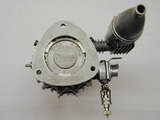|
|
In 1969, the Ogawa Seisakucho of Tokyo, Japan began manufacturing the world's first model rotary piston engine, the .30 cid Graupner-O.S. Wankel based on the German NSU/Wankel patents. The fact that two of the world's largest model firms, Johannes Graupner of Germany and Ogawa Model Mfg. Co., of Japan had seen fit to allocate considerable resources to the development of the engine, projected success for the venture. In 1954 Felix Wankel discovered the concept, the rotating of a triangular piston or rotor in an epitrochoidal (e-pit-ro-koy-dull) shaped chamber. After considerable full sized motor car experimentation in Germany and Japan, the Graupner organization worked for over 6 years and then enlisted the help of O.S. who put another two years into the project before bringing it to market in 1970 at $87.50 retail as part of the extensive O. S. model engine line.
Like a four-cycle reciprocating engine it has induction, compression and exhaust strokes. It achieves this without the complications of valves and valve-operating gear. Instead the engine breathes through ports that are opened and closed by the rotary piston. It therefore, combines in these respects, the merits of both the four-cycle and the two-cycle engine, but it has a triangular shaped piston that travels round and round instead of a cylindrical one that goes up and down †. An improved 1st model Wankel .30 R/C was perfected by OS Chief Engineer Kazuhiro Mihara with Thunder Tiger Engines in Taiwan after the death of O. S. owner Shigeo Ogawa had overcome the initial problems of power and weight.
 |
 |
 |
The carburetor is basically identical to that of the Max 30 R/C at the time, and is located under the prop drive with the special glow plug at the l'oclock position. The cooling fins extend around the entire engine. A radial mount forms the back of the case. All are beautifully cast by specially designed casting forms. Internally the rotor is mounted on the eccentric shaft via a l2mm caged, needle bearing and is fitted with special castiron apex seals, each backed by a pair of high carbon steel leaf springs to keep the seals tight. The shaft, itself, is carried in two ball bearings and a needle bearing and the weight of the eccentric and rotor are balanced by counterweights front and rear. The phasing gears are case-hardened nickel-chrome steel. The muffler is a simple expansion type that clamps directly onto the exhaust stub that is a part of the engine's pressure-cast cooling ring. It is the quietest of model engines and practically vibration free. Maximum torque is 52 cid at around 9,000 rpms and peak output reached .67 bhp at just over 16,000 rpms. The power available at the 1970 testing was greater than most of the R/C 35s and 40s. In brief, high power, excellent throttling, smooth running, quiet, east mounting and compact but heavier and more expensive than the two-cycles of the day describe this engine.
The former World Engines, Inc. of Cincinnati, Ohio headed by John Maloney was the first importer of the engine. (With Maloney's passing, INDY, R/C took over.) The Wankel .30 has never caught on as a collecting engine, but when one finds an NIB the price is double the 1969-70 retail. It is exceedingly beautifully made! In the late 70's rumor of a new model Wankel .30 circulated giving fruit in the early 1980's to the current model, more than twice as powerful as the original and imported by Tower Hobbies, of Champaign, Ill. Current price is around $250 discount, $400 retail. Pick one up now, fellas as prices can only go up! A bargain!
† Over the years, the "Dean" of model engine reviewers, P. G. F. Chinn of England, has been the definitive "word" on the new model engines coming into the market. In his "Engine Review" article on the Wankel, Model Airplane News, Sept/Oct. 1970 and April, 1972 he has never "waxed" more eloquently.
 Back to Model Engine News Home
Back to Model Engine News Home
Back to Janson Index Please submit all questions and comments to [email protected]